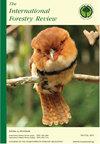Regulations Matter: Their Effects on Actors of the Nonindustrial Timber Value Chain in the Southern Highlands of Tanzania
IF 0.9
4区 农林科学
Q2 FORESTRY
引用次数: 1
Abstract
HIGHLIGHTS The government is the sole regulator of the timber value chain. However, regulations are implemented differently at the sub-national level. All value chain actors operate under the same regulatory framework despite their many differences. Some regulations are perceived as being cumbersome by the value chain actors. Although regulations affect all actors of the value chain, tree growers are the most-affected category. Government revenue is lost due to some strategies adopted by the chain actors to maximize their incomes. SUMMARY In recent years, non-industrial private forestry (NIPF) for timber production has gained economic importance in the Southern Highlands of Tanzania. Access to benefits accrued from NIPF represents an opportunity for poverty alleviation. Access and distribution of the benefits are affected by governance, which is an important aspect in this regard. This paper focuses on state regulations, which in the context of Africa and Tanzania in particular, have received scant attention in the value chain studies. The paper seeks to respond to three main questions: i) How is the timber value chain regulated? (ii) What strategies do the value chain actors use to gain access to benefits? And iii) how do regulations affect the incomes of the chain actors? Data for the study were collected from Njombe District through documentary analysis, focus group discussions, observations and in-depth interviews with key informants. The study findings show that while the government is the sole regulator of the chain, regulations are implemented differently at the sub-national level. Industrial and non-industrial private forestry are placed under the same regulatory framework despite their many differences. This has partly resulted in high transaction costs, which are unaffordable by the majority of actors in the NIPF value chain. Despite strict regulations and many taxes paid, the actors adopt different strategies such as using locally available materials and capitalizing on social networks in maximizing their incomes from the timber business. The regulations affect incomes of all actors, however, tree growers are the most-affected category. This is because tree growers possess limited capital to engage in high value chain activities and strict regulations aggravate the situation. The paper concludes that the contribution of non-industrial private forestry to poverty alleviation is stifled by cumbersome district and state regulations that limit actors' access to profitable markets.法规至关重要:它们对坦桑尼亚南部高地非工业木材价值链参与者的影响
亮点政府是木材价值链的唯一监管机构。然而,地方一级的法规执行情况有所不同。所有价值链参与者都在同一监管框架下运作,尽管存在许多差异。一些监管被价值链参与者认为是繁琐的。尽管法规影响到价值链的所有参与者,但树木种植者是受影响最大的类别。由于连锁经营者为最大限度地提高收入而采取的一些策略,政府收入损失。摘要近年来,用于木材生产的非工业私营林业(NIPF)在坦桑尼亚南部高地具有重要的经济意义。获得国家实施计划基金积累的福利是减轻贫困的一个机会。收益的获取和分配受到治理的影响,这是这方面的一个重要方面。本文关注的是国家法规,尤其是在非洲和坦桑尼亚,这些法规在价值链研究中很少受到关注。本文试图回答三个主要问题:一)木材价值链是如何监管的?(ii)价值链参与者使用哪些策略来获得利益?三)监管如何影响连锁经营者的收入?该研究的数据是通过文献分析、焦点小组讨论、观察和对关键线人的深入采访从Njonbe区收集的。研究结果表明,虽然政府是供应链的唯一监管机构,但地方一级的监管实施方式不同。工业和非工业私营林业被置于同一监管框架下,尽管它们有许多差异。这在一定程度上导致了高交易成本,而NIPF价值链中的大多数参与者都负担不起。尽管有严格的法规和缴纳的许多税款,但行为者采取了不同的策略,如使用当地可用的材料和利用社交网络最大限度地提高木材业务的收入。这些规定影响到所有参与者的收入,然而,树木种植者是受影响最大的类别。这是因为树木种植者从事高价值链活动的资本有限,而严格的监管加剧了这种情况。该文件的结论是,非工业私营林业对扶贫的贡献被繁琐的地区和州法规所扼杀,这些法规限制了行为者进入有利可图的市场。
本文章由计算机程序翻译,如有差异,请以英文原文为准。
求助全文
约1分钟内获得全文
求助全文
来源期刊

International Forestry Review
农林科学-林学
CiteScore
2.50
自引率
6.20%
发文量
29
审稿时长
>36 weeks
期刊介绍:
The International Forestry Review is a peer-reviewed scholarly journal that publishes original research and review papers on forest policy and science, with an emphasis on issues of transnational significance. It is published four times per year, in March, June, September and December. Special Issues are a regular feature and attract a wide audience. Click here for subscription details.
 求助内容:
求助内容: 应助结果提醒方式:
应助结果提醒方式:


